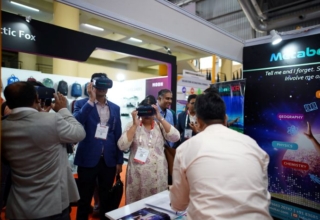
The unfortunate spate of teen suicides attributed to ‘killer’ online game, ‘Blue Whale Challenge’, which is claiming almost a life every week in past few weeks in India, has put the Online Gaming in a tight spot with parents, teachers and schools worried about children, who are vastly hooked to gaming. A large number of anxious parents are trying hard to snap online access to their children. Is that the right route? The UNESCO’s MGIEP a few months ago launched world rescue (http://worldrescuegame.com/), a mobile-based game , only a couple of months ago for bettering learning and sensitization of Sustainable Development Goals (SDGs) among young people. Another gaming platform http://gamifi-ed.wikispaces.com/ is already an education system in itself. That is to say that power of gaming has been already recognized and it is thriving economy with some games bigger than Hollywood blockbusters. In this scenario, it is better to get expert advise.
Autar Nehru met Manvendra Shukul- CEO of Lakshya Digital, one of India’s pioneering game art developer who now executes global gaming projects with his team based in Gurgaon, to understand gaming trends and also to know if parents can do something to stop worrying
 The ‘Blue Whale Challenge’ linked suicides has brought online games into sharp focus for bad reasons, so do you agree that game art can have a dark side. Do we have any kind of regulations international or otherwise to prevent this?
The ‘Blue Whale Challenge’ linked suicides has brought online games into sharp focus for bad reasons, so do you agree that game art can have a dark side. Do we have any kind of regulations international or otherwise to prevent this?
The Blue Whale Challenge would suggest that games might have a dark side. In exactly the same way as any other entertainment medium like books, movies or music do. Games do not make people any more violent or peaceful than movies, music or books do. The regulations that apply to gaming is more or less the same as those that apply to anything present on the internet. Like with any regulation, it is not good enough to have it. What makes regulations work is how well they are enforced. And so like any other regulation they are not fool-proof. What is required is for users of the internet to be cautious of the websites they visit and the games they play and steer away from predators just as one would on the street at night time in one’s own city.
Now let’s come to the positive side of gamification. It is being said that some games are bigger than Hollywood movies. And online games have established themselves firmly and it is already a big industry. Can you briefly give us a sense of the gaming world and how is it evolving?
The gaming industry is growing across the world and is currently pegged at $ 92 billion USD globally. Gaming is the largest segment within the Entertainment Industry, far exceeding Movies, Music & Animation.
The growth is driven by a growing youth population, higher disposable incomes, introduction of new gaming genres and the increasing number of smartphone and tablet users following on the back of improving connectivity across the world. Mobile is the most lucrative segment, with smartphone and tablet gaming growing 19% year over year to $46.1 billion, claiming 42% of the market. In 2020, mobile gaming will represent more than half of the total games market.
In last 2-3 years, gaming industry has witnessed unique trends and developments in gaming industry across the globe. There has been exit of Console Cycles and entry of Incremental Console Updates. Secondly, there has been the rise of Augmented Reality (AR). With the runaway success of Pokémon Go in 2016, Augmented Reality (AR) stepped out of the shadows of its better known sibling Virtual Reality (VR). A host of companies have now jumped on to the AR gaming bandwagon.
Also, Competitive gaming, or eSports has also blossomed over last few years and will continue in future as well. Competitive gaming, where professional video game players compete against each other for a top prize (which is usually a lot of money), really came into its own in 2016. The next big thing is TV. As consoles evolve into something more, resembling multimedia entertainment devices than dedicated gaming machines, it seems that everyone wants an in on the widespread accessibility of the dominating mobile market model. At this point the next stop for tablets and smartphones is going to be to connect to TVs.The future is of 4K gaming that targets masses.
Games are interactive, there is a freedom to fail, engagement, rewards and even e-tournaments, how is all this going to impact young minds. How do we leverage this into learning and knowledge acquisition?
‘Learning through action’ as a concept is increasingly being recognized and promoted in classrooms across the world. Researchers have found that cognitive flexibility can be improved using fun learning tools like gaming. The very manner in which computer games are designed, encourages improved brain functions such as decision making skills. Gaming can also be an excellent motivator for learning, and is a commonly used teaching method used to keep children engaged. Computer games help kids develop an understanding of their own intelligence and areas of skill through specific encouragement and feedback. Games do this by rewarding players for completing levels, or placing them on a table of high scores.
Do you think AR & VR is assisting in gamification of education?
AR and VR are new content platforms that have a tremendous potential for impacting education and making it more effective and progressive. But, these are new platforms and still in a stage where developers are experimenting with the possibilities. There are some developers who are doing great work that impacts the way education of the future will happen. But, they are still experiments that are creating possibilities and will take some time before they can be utilised in the mainstream education. Having said that, I truly believe that AR has a bigger potential to impact education than VR and in the coming years it will change the way our kids get educated. This platform has the potential to bring about a complete paradigm shift in how we see education for our kids in the very near future.
Coming to India, though a lot of Indians are immersed in gaming yet our contribution to this emergent industry isn’t that much even though India is one of the leading nations of IT service and product exports. Your comment how bodies like NASSCOM are addressing this?
First, we need to understand where the Indian gaming industry stands vis a vis the global games industry which has been around for a very very long time, more than 45 – 50 years. That is sufficient time for an industry to become mature and work as a professional entity. Hence it is now the largest segment of the digital entertainment industry. Bigger than the US movie and music industry. On the other hand, Indian games industry is very new. Just about 7-8 years old. We are still in the process of learning the ropes and are grappling around to find a foothold in this space. The global games industry was 92 billion USD last year and is expected to cross 100 billion dollar mark this year while the Indian games industry is a fledgling 300 million USD. the Indian market is where the US was 40 years ago. Parents still frown on kids playing video games. In the US, on the other hand, e-sports tournaments such as DOTA2 International have a prize money pool of nearly $19 million. Having said that, the rate at which the Indian games industry has started growing in the last couple of years, makes it very evident that we will not take as long as the US industry to make our presence known in the global arena. In the last couple of years more than 100 Game developers have come up to take the challenge of making their own games. And that is a very definite sign that the industry is soon going to come out of the shadows and start its journey to the top. Where all global publishers and developers would want to have a foot in. With the size of the Indian smart phone market moving fast towards the number one spot, the mobile games market is just waiting to explode. And when that happens, there is no stopping the Indian Games Juggernaut.
The Nasscom Gaming Forum (NGF) runs many initiatives that aim to help grow the Indian gaming eco-system. The primary goal of these initiatives is to promote/ present video game development as a viable career option and also help Indian developers get access to appropriate knowledge, skills, publishers and investors that can help them mature and succeed.
Some of these initiatives are:
- Game Jam Titans: A country-wide annual game development competition for school children. The aim of this initiative is to get students involved in game development from a young age.
- NGF City Chapters: The city chapters provide developers a networking and knowledge sharing platform with local peers.
- The Nasscom Game Developers Conference (NGDC): Annual conference of game developers comprising of talks, workshops, panel discussions, expo etc. The conference provides developers a unique opportunity to learn from Indian and international Industry experts, and to also connect with peers from across the country.
- The NGF Awards: Annual awards that recognize the best games from India.
- Investor and Publisher Meet-ups: These help local developers get access to Publishers and Investors.
Tell us about yourself how did you develop an interest in gaming as a result of which Lakshya Digital was probably born?
I started my career as computer programmer back in 1986. In 1995, when I saw the world’s first 3d video game (Wolfenstein), I was blown away and curious to know how it was developed. It is that curiosity that motivated me to do something similar here in India.
I set up a company named Microcosm that developed the country’s first 3D game engine. In 2000, Escosoft acquired Microcosm and later I set up an animation studio for Escosoft named Escotoonz. In the next three years, Escotoonz went on to became one of the largest animation studio in the country. In 2004, I set up my own Video Games Development services company called “Lakshya Digital” with 2 other co-founders. We started with a focus on creating game art and animation for global game developers and publishers.
Briefly explain to us what kind of work you do and what is the arrangement with Keywords Studios? Also, if can mention some major projects.
Dublin Based Keywords Studio acquired Lakshya Digital in the year 2014. Now as part of the Keywords group,Lakshya has given Keywords access to the exciting game art development talent in India. Working closely with Keywords and capitalizing on their global presence, we have been able to create additional growth opportunities as well as create cost and revenue synergies.
The acquisition has helped Lakshya’s highly talented employees with growth opportunities while Lakshya continues to build upon its strong brand, leveraging Keywords’ unparalleled geographic footprint, client relationship and financial strength.
Lakshya Digital currently has studios in Gurugram, Pune and Seattle (US), and is a leading provider of outsourced art and animation services for video game developers and publishers.
 Lakshya Digital has been working with some of the biggest names in the space over the last 13 years. Game Art and animation for some of the biggest games titles globally has been created right here in our studios in Gurgaon and Pune. While we may not be able to reveal all names (due to non-disclosure pacts), below are names of some select games that Lakshya has worked on. Kingdom Hearts 2.8 from Square Enix, Sea of Thieves from Rare Studios, Just Cause III from Avalanche Studios, are hugely popular titles that Lakshya has worked on recently. Apart from these some of the earlier title are:
Lakshya Digital has been working with some of the biggest names in the space over the last 13 years. Game Art and animation for some of the biggest games titles globally has been created right here in our studios in Gurgaon and Pune. While we may not be able to reveal all names (due to non-disclosure pacts), below are names of some select games that Lakshya has worked on. Kingdom Hearts 2.8 from Square Enix, Sea of Thieves from Rare Studios, Just Cause III from Avalanche Studios, are hugely popular titles that Lakshya has worked on recently. Apart from these some of the earlier title are:
| Developer | Game Title |
| From Software | Bloodborne |
| Avalanche Studios | Just Cause 3 – delete as written above |
| Yukes | WWE2k16 |
| Mercenary Technology | Call of Duty: Black Ops III (X360 version) |
You are also running a training/skilling academy. Provide us an overview and how you’re selecting people for this. What is eligibility or who are the people you are looking at and what are career prospects. Also, an estimate how many jobs are available in the industry ?
Lakshya Digital runs inGame, a training Institute, to make high quality professional training in game art creation available to talented artists. inGame provides hands on training by experienced industry experts & offers courses in the creation of 3D art assets for games. What makes inGame stand apart from other traditional training programs is the focuses on hands-on/practical sessions that makes students job-ready. The course is offered in both our local studios in Gurgaon and Pune. The trained artists at inGame can further pursue their career by joining Lakshya’s Art Team and get the opportunity to work on world-class game titles.
We select candidates on thebasisoftheir interest and understanding of game art development. They should have passion for game art along with basic knowledge of software & tools like Adobe Photoshop, Maya etc. The learners are required to undergo a basic evaluation to understand their knowledge, before they are shortlisted for the training program.
The gaming art industry has immense scope for youth to build their careers. The game art industry in India requires a steady inflow of professionals in next 5 years to cope with both outsourced work from leading countries in games development space like the US and Japan as well as increasing domestic demand as India goes digital. Gaming as an industry offers career opportunities in different functional areas such as Game Design, Game Art creation in 3D and 2D, Game Animation, Game Programming, Game Testing, Project Management, and other general management areas.
Lastly, one question that is on every parent’s mind how to control children from overdose of gaming as they neglect other things and also how best can dangerous stuff we talked about in the beginning be tackled?
The first and foremost fact we need to recognize is that “Children will be children”. That does not mean that we do not influence their choices and just let them be. What that means is that they will continue to be lured by things that may not ‘seemingly’ be in their best interest. If a few decades back it was spending more time with friends &playing outdoors, rather than studying, then today playing outdoors has been replaced by spending time on the internet. Of course, the argument remains whether playing outdoors & internet usage is harmful in the first place. But that argument aside, we need to recognize the fact that today’s children have entirely integrated the Internet in their interaction with others. The Internet provides a great many opportunities for children to spend their leisure time, to learn, to express themselves and to influence decision making.
Considering this parents need to focus their effort on not stopping kids from using the internet but on educating them on safe and moderate usage of internet & gaming. They need to make children aware of the dangers lurking on the net, wary of the websites they visit and the games they play, and steer away from predators just as you would on the street at night time in your own city.










